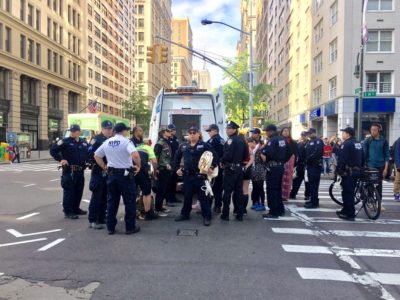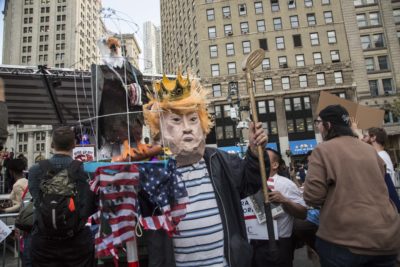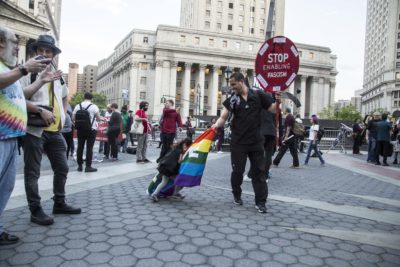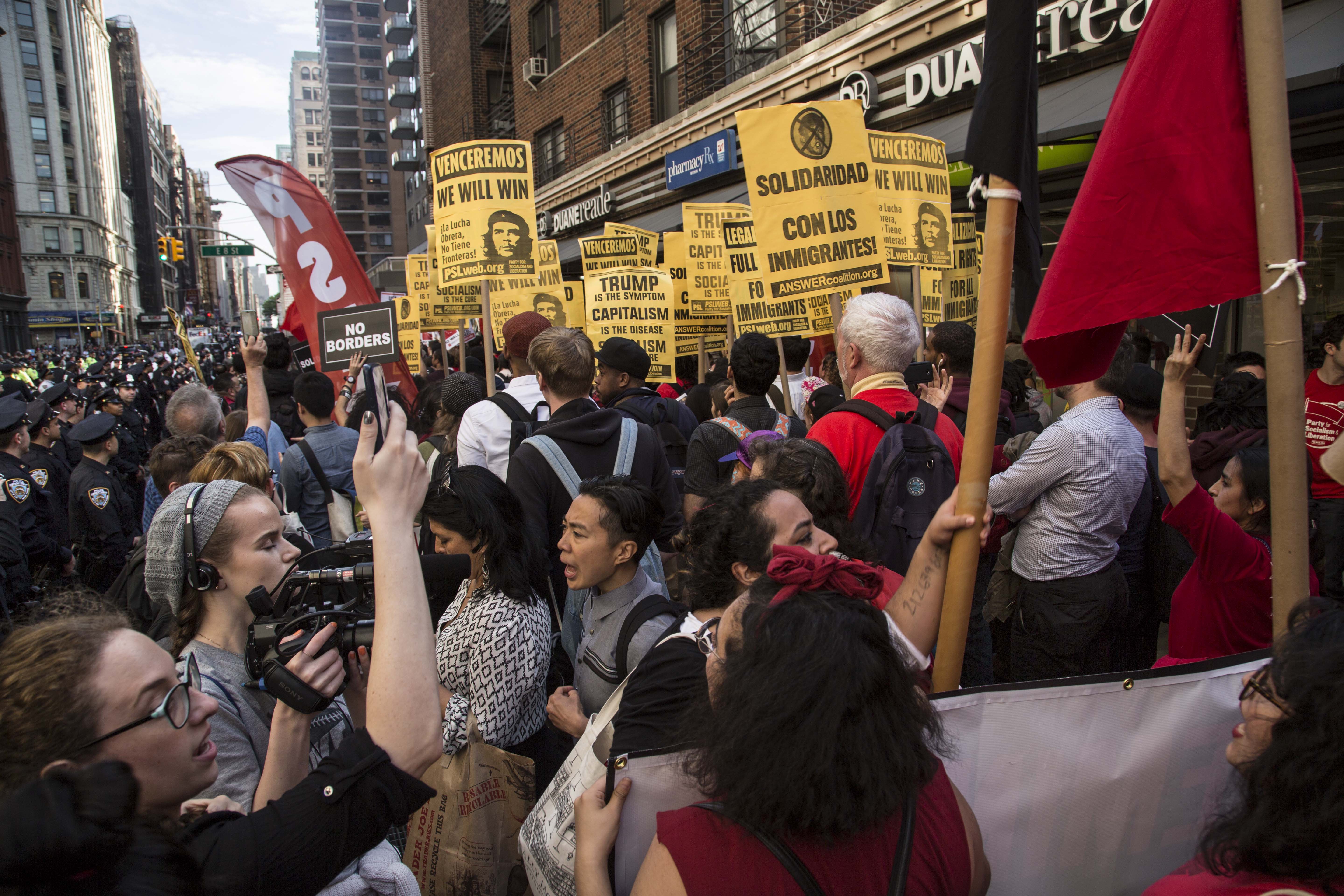Police helicopters buzzed overhead, as stretches of protesters marched along Broadway, waving colorful flags and signs on Monday, May 1, also known as May Day.
Lines of police with loops of white zip ties hanging from their belts walked alongside protesters, limiting them to the sidewalk. Recorded instructions repeatedly blasted from a loudspeaker announcing, “Pedestrians are not permitted to walk in the street or roadway” and that “any obstruction can lead to arrest.”
May Day, historically a day to show support for workers’ rights and labor issues, was used to protest a variety of causes this year. Protesters chanted and marched in Washington Square, Union Square, down Broadway to Foley Square over the course of the the evening.
“I think it’s a little disorganized, people are protesting different things, but the main theme is there’s a problem in our political system today and we as a united front need to stand against it,” said New School student and marcher Katie Stromin.
Among those marching were SENS-UAW organizers and supporters — some of whom were supporters from outside The New School. SENS-UAW is made up of graduate and undergraduate student employees at The New School. They are voting to unionize this week and marched in support of the vote.
Stromin joined the march, her first May Day rally, when she saw protests start up. She skipped her class because she felt it was important to participate and show support.
“I think with our political climate right now, it’s important to involve yourself in protests,” Stromin said.
At least one New School student was arrested at Monday’s May Day protests.
The student who identified herself as Noura Farouq was taken into police custody near the University Center. A Palestinian-Lebanese, first generation American, she was protesting with the New York City Students For Justice In Palestine, voicing solidarity for the Palestinian hunger strike that protests the detainment of political prisoners.
“I wasn’t expecting [my arrest] at all. I was overall shocked that it happened. I was expecting to come back home and finish my finals,” Farouq said. She was released from police custody at around 10 at night.
Most of the 32 people taken into custody during the protests received desk appearance tickets for disorderly conduct, according to New York Daily News.

Marchers included labor unions, socialists, people protesting police brutality, people supporting immigrant rights, as well as general anti-Trump protesters.
Having obtained a sign from a departing protester, Talar Kupelian joined the march after she got out from work. Kupelian felt it was important because she has family members in Syria and is a child of immigrants.
Tambourines and drums kept the beat of protest chants and songs — some heard in other languages. The chants ranged from “Hey hey ho ho, the 1 percent has got to go” to “Fuck the wall, we’ll tear it down.”
“We are unstoppable. Another world is possible,” one protester chanted. He added on his own ending, saying, “We could use a lozenge though,” as his voice noticeably cracked.

A group dressed in all black joined in after being temporarily separated from the main march at Washington Square where several individuals were arrested for wearing bandannas over their faces, which violates New York Penal Law 240.35(4).
A NYPD officer chanted to protesters to “keep on the sidewalk,” clapping his hands. A group of teenagers played “Fuck tha police” by N.W.A, middle fingers in the air, dancing, and making eye contact with unfazed officers.
“What we really need now is a Pepsi,” one person in the crowd joked, likely referencing a recent controversial Pepsi commercial. A police officer across from her responded with a smirk, “We don’t need none of that.”
The march ended at Foley Square, where several different speakers addressed the crowd from a small stage. Later in the evening, the motivational speeches were swapped for live music performances.

As music blasted from the speakers, some protesters began celebratory dancing. One marcher dressed in head-to-toe black attire found a dance partner in a little girl who wore a Batman dress and waved a rainbow “Peace” flag. As she twirled and waved the colorful flag, the man bobbed a “Stop enabling fascism” sign up and down to the beat of the music.
An older couple sat in lounge chairs at the back of Foley Square listening to speakers on stage, including Mayor Bill de Blasio.
“Everything Donald Trump wants to do, I have a simple message: No, you can’t! No se puede!” de Blasio shouted to the crowd.
Photos by Julia Himmel
Seung Won is the Video Editor for the New School Free Press and currently a senior at Lang majoring in Journalism+Design and minoring in Visual Studies. Born and raised in North Jersey, Seung Won has embraced and mastered the commute into the city, seamlessly weaving through crowds and covering miles of distance without breaking a sweat. When not in transit, Seung Won likes playing music on his guitar, sipping through several cups of coffee, and chillin’ with his cat on the weekends.







